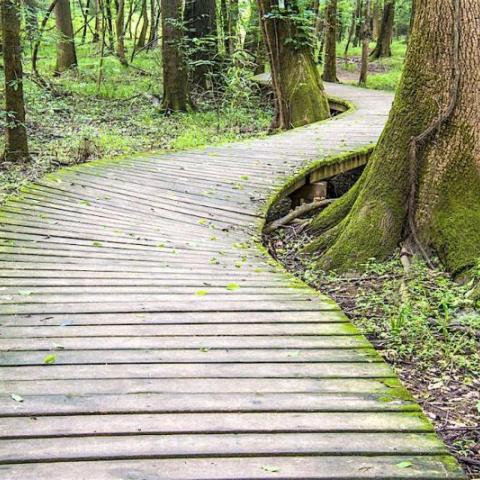
Yellow-throated Warblers are among the birds hanging out in Congaree National Park in South Carolina these days/Kirby Adams
What does a birder do when the wait for the peak of spring migration is just taking too darned long? One option is to head south. Early April is a great time to visit the parks of the southeast for a little bit of the warbler action that won’t get to the north until May. Florida is certainly one option, but for a little more seclusion with plenty of songbirds, Congaree National Park in South Carolina is the place to be.
We’ve mentioned Congaree as a spot of special concern for the Rusty Blackbird Spring Migration Blitz, but the park is much more than winter habitat for blackbirds.
Woodpeckers abound at Congaree. Walk the boardwalk or paddle Cedar Creek and you’re guaranteed to have a Pileated Woodpecker glide past you, weaving its way through the tupelo and cypress maze. In the quiet of the bottomland swamp, you’ll hear two, maybe three, deep wingbeats as the Pileated alights, then nothing but a silent, purposeful glide. Those first flaps would be the only indication the woodpeckers were around were it not for the occasional piercing and maniacal laughter they unleash.
Red-bellied Woodpeckers also contribute their cackle to the woodland, seeming much louder than they do in a mixed forest of the north. Once the morning chorus of birdsong is over, the floodplain can be eerily quiet, so the periodic outburst from a woodpecker is both welcome and jarring.
Songbirds are the real treat for a winter-weary northerner in Congaree. The parking lot at the Harry Hampton Visitor Center hosts a cacophony at dawn right up until they open the doors at 9 a.m. Yellow-throated Warblers will sing from high perches, trying to drown out the roaming gangs of Tufted Titmice. Every few minutes a Carolina Wren will uncork its penetrating tea-kettle tea-kettle tea-kettle, proving that the wrens are pound-for-pound the loudest birds in the forest.
Lost in all the other singing is the Northern Parula. This warbler nests in Congaree and the rest of the Southeast, then not in a large swath of the Midwest, but is again a nester in northern Michigan and well into Canada. No one is quite certain why their nesting range is broken up that way, but there’s no doubt they’re the featured warbler at Congaree. Their buzzy, ascending song can be a bit difficult to hear among all the competition, but when an inquisitive male drops into lower branches to check things out, they steal the show.
White-eyed Vireos are a southern specialty that spices up the trails of Congaree. The bird itself is stunning with its yellow spectacles are ghostly white irises. They are often singing from the understory and lower branches, so a patient birder can track them down for a good view. Besides being a fine looking bird, they have a distinctive and memorable song. Some people who enjoy birdsong mnemonics say it can be rendered as “quick! take me to the railroad, quick!” I’m not personally sure why the vireos need to get to the railroad in such a hurry, and I have to admit it’s one of the mnemonics that doesn’t really work for me. Once you see one sing, you aren’t likely to forget it, unless you typically go a year or more between White-eyed Vireo sightings.
When you’re done birding the “swamp,” stop in the visitor center and let them know what you saw. You may even run into someone with a good deal of bird knowledge, like Ranger Patrick Hair. When he isn’t leading snowshoe hikes at Bryce Canyon, he can tell you which trees to check for the elusive Brown-headed Nuthatch outside Congaree's visitor center.
Great birds, quiet trails, a fabulous modern visitor center, and some of the friendliest rangers in the game make Congaree an essential birding destination.


 Support Essential Coverage of Essential Places
Support Essential Coverage of Essential Places







Comments
So forrunate to have Patrick with his sensitivity to bird song and desire to increase our knowledge!